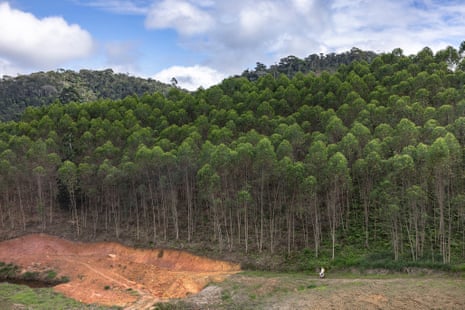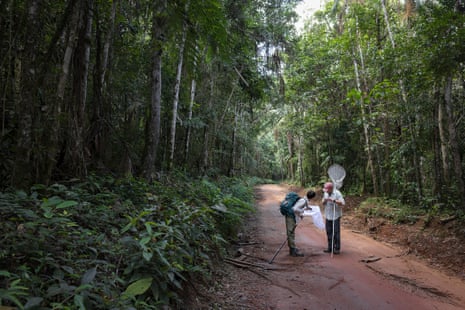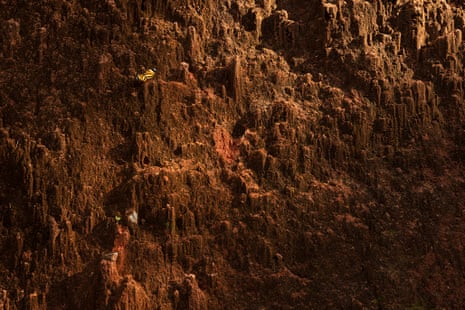Fade to grey: as forests are cut down, butterflies are losing their colours
The world is becoming less colourful. For butterflies, bold and bright wings once meant survival, helping them attract mates and hide from prey. But a new research project suggests that as humans replace rich tropical forests with monochrome, the colour of other creatures is leaching away.“The colours on a butterfly’s wings are not trivial – they have been designed over millions of years,” says researcher and photographer Roberto García-Roa, who is part of a project in Brazil documenting how habitat loss is bleaching the natural world of colour.Whether dazzlingly red, deep green or ghostly pale, the richness of a tropical forest provides butterflies with a diversity of habitats in which to communicate, camouflage and reproduce. As humans replace tropical forests with environments such as eucalyptus monocultures, however, those requirements are changing. In a plantation, the ecological backdrop is stripped bare and drab species do better. Being bland – like your surroundings – becomes an advantage.The difference is stark, researchers say. “You feel alive in the tropical forest, everything is wild – you never know what you are going to find,” says García-Roa. “When you arrive at a eucalyptus plantation it’s very frustrating – you can feel that things are not happening as they should be in a natural ecosystem. Animals are not around, and sounds are not as they should be.”Discoloration Eucalyptus plantations, such as this one in Espírito Santo, Brazil, are warmer, drier and flooded with direct light, compared with cooler, humid mature forests These preliminary findings are part of a broader body of research into “discoloration”, which examines how nature loss is altering the colours of the natural world.Butterflies are an ideal subject for study because they are among the most colourful organisms in the world. They display a vast array of colours across habitats, respond quickly to environmental changes and are easy to monitor.Colour isn’t just about aesthetics, it has important evolutionary functions. In a broader trend, ecosystems that once supported many colours are becoming more muted as they are degraded, simplified and polluted by humans. Coral reefs are bleaching, oceans are becoming greener – even rainbows are predicted to become less visible in densely populated and polluted areas.One obvious thing is that in eucalyptus plantations, butterfly communities are dominated by brown-coloured speciesMaider Iglesias-Carrasco, researcherNature’s palette is always changing in response to natural selection pressures. A notable mid 20th-century example is the peppered moth, which turned black during the Industrial Revolution to fit in with the sooty surroundings. But there are likely to be more rapid and widespread changes ahead due to human activity. “Even planet Earth itself is losing brightness as seen from space. It is truly remarkable and concerning how interconnected these processes are, and how every impact cascades into further consequences,” says Ricardo Spaniol from the Federal University of Rio Grande do Sul.So far, researchers have identified 21 species in eucalyptus plantations and 31 in the natural forest, although there are many yet to be identified. They studied forests and plantations in the Brazilian state of Espírito Santo, north of Rio de Janeiro. “One thing that is obvious is that in eucalyptus plantations, butterfly communities are dominated by brown-coloured species,” says lead researcher, Maider Iglesias-Carrasco from the University of Copenhagen. There was a “general feeling of emptiness” in the plantations, she added.Amazonian butterfliesResearchers first discovered that being colourful in the Amazon may be turning into a disadvantage in 2019. Spaniol spent several weeks in the rainforest, and his team discovered butterfly species changed significantly depending on their environment, and their colours followed suit.“The most colourful species are often the first to disappear locally after deforestation, probably because of the loss of native vegetation and their increased exposure to predators. This represents an accelerated process of discoloration in Amazonian butterfly communities,” says Spaniol.Butterflies that persisted in deforested areas typically had brown or grey wings and bodies. In a preserved forest, however, a dazzling array of very colourful butterflies were found alongside the duller ones. Researchers did not expect to find such a clear and consistent pattern, and say it opened up a new area of research on how habitat loss can shape diversity.“Discovering that forests are losing their colours was frightening and revelatory,” says Spaniol. “It felt like we were uncovering a hidden dimension of how species respond to environmental change, a dimension that had remained invisible until then, but is incredibly rich.” When the colour diversity decreases, it may signal the erosion of ecological functioning.Butterflies are often considered indicators of broader biodiversity trends, says Spaniol: “A decline in their colour diversity may reflect a loss of complexity in ecosystems as a whole, with potential cascading effects on other organisms and ecological processes.”Protecting nature-rich forests Tropical forests, such as the Santa Lúcia biological reserve in Brazil, encompass a wide range of microhabitats. The more complex the habitat, the more opportunities butterflies have to develop diverse traits From the Amazon rainforest to California to Spain, monoculture forests are being grown over huge areas. According to one estimate, eucalyptus plantations – among the most common type, farmed for wood pulp, timber and toilet paper – cover at least 22m hectares (54m acres) around the world.Researchers don’t know whether the impact of plantations is homogeneous across the planet. “Coffee and banana plantations are always green, and people associate green with nature, but they are not [natural],” says García-Roa.If nothing is done to protect native habitats and prevent the further loss of forests, many of the most colourful and ecologically specialised species of butterfly could disappear, leaving behind only a few generalist species. “This would mean not only a loss of beauty, but also the disruption of important ecological interactions that depend on colour signals,” says Spaniol.However, this outcome is not inevitable. Spaniol’s research found that forested habitats in the Amazon rainforest that have been regenerating for 30 years after being used as cattle pasture showed a remarkable increase in butterfly colour diversity. “We still have the opportunity to restore this colourful world,” he says.Find more age of extinction coverage here, and follow the biodiversity reporters Phoebe Weston and Patrick Greenfield in the Guardian app for more nature coverage
The insects’ brilliant hues evolved in lush ecosystems to help them survive. Now they are becoming more muted to adapt to degraded landscapes – and they are not the only things dulling downPhotographs by Roberto García-RoaThe world is becoming less colourful. For butterflies, bold and bright wings once meant survival, helping them attract mates and hide from prey. But a new research project suggests that as humans replace rich tropical forests with monochrome, the colour of other creatures is leaching away.“The colours on a butterfly’s wings are not trivial – they have been designed over millions of years,” says researcher and photographer Roberto García-Roa, who is part of a project in Brazil documenting how habitat loss is bleaching the natural world of colour.Amiga arnaca found in a eucalyptus plantation, where scientists observed butterflies were less colourful than in native forests Continue reading...
The world is becoming less colourful. For butterflies, bold and bright wings once meant survival, helping them attract mates and hide from prey. But a new research project suggests that as humans replace rich tropical forests with monochrome, the colour of other creatures is leaching away.
“The colours on a butterfly’s wings are not trivial – they have been designed over millions of years,” says researcher and photographer Roberto García-Roa, who is part of a project in Brazil documenting how habitat loss is bleaching the natural world of colour.
Whether dazzlingly red, deep green or ghostly pale, the richness of a tropical forest provides butterflies with a diversity of habitats in which to communicate, camouflage and reproduce. As humans replace tropical forests with environments such as eucalyptus monocultures, however, those requirements are changing. In a plantation, the ecological backdrop is stripped bare and drab species do better. Being bland – like your surroundings – becomes an advantage.
The difference is stark, researchers say. “You feel alive in the tropical forest, everything is wild – you never know what you are going to find,” says García-Roa. “When you arrive at a eucalyptus plantation it’s very frustrating – you can feel that things are not happening as they should be in a natural ecosystem. Animals are not around, and sounds are not as they should be.”

Discoloration
-
Eucalyptus plantations, such as this one in Espírito Santo, Brazil, are warmer, drier and flooded with direct light, compared with cooler, humid mature forests
These preliminary findings are part of a broader body of research into “discoloration”, which examines how nature loss is altering the colours of the natural world.
Butterflies are an ideal subject for study because they are among the most colourful organisms in the world. They display a vast array of colours across habitats, respond quickly to environmental changes and are easy to monitor.
Colour isn’t just about aesthetics, it has important evolutionary functions. In a broader trend, ecosystems that once supported many colours are becoming more muted as they are degraded, simplified and polluted by humans. Coral reefs are bleaching, oceans are becoming greener – even rainbows are predicted to become less visible in densely populated and polluted areas.
Nature’s palette is always changing in response to natural selection pressures. A notable mid 20th-century example is the peppered moth, which turned black during the Industrial Revolution to fit in with the sooty surroundings. But there are likely to be more rapid and widespread changes ahead due to human activity. “Even planet Earth itself is losing brightness as seen from space. It is truly remarkable and concerning how interconnected these processes are, and how every impact cascades into further consequences,” says Ricardo Spaniol from the Federal University of Rio Grande do Sul.
So far, researchers have identified 21 species in eucalyptus plantations and 31 in the natural forest, although there are many yet to be identified. They studied forests and plantations in the Brazilian state of Espírito Santo, north of Rio de Janeiro. “One thing that is obvious is that in eucalyptus plantations, butterfly communities are dominated by brown-coloured species,” says lead researcher, Maider Iglesias-Carrasco from the University of Copenhagen. There was a “general feeling of emptiness” in the plantations, she added.

Amazonian butterflies
Researchers first discovered that being colourful in the Amazon may be turning into a disadvantage in 2019. Spaniol spent several weeks in the rainforest, and his team discovered butterfly species changed significantly depending on their environment, and their colours followed suit.
“The most colourful species are often the first to disappear locally after deforestation, probably because of the loss of native vegetation and their increased exposure to predators. This represents an accelerated process of discoloration in Amazonian butterfly communities,” says Spaniol.
Butterflies that persisted in deforested areas typically had brown or grey wings and bodies. In a preserved forest, however, a dazzling array of very colourful butterflies were found alongside the duller ones. Researchers did not expect to find such a clear and consistent pattern, and say it opened up a new area of research on how habitat loss can shape diversity.
“Discovering that forests are losing their colours was frightening and revelatory,” says Spaniol. “It felt like we were uncovering a hidden dimension of how species respond to environmental change, a dimension that had remained invisible until then, but is incredibly rich.” When the colour diversity decreases, it may signal the erosion of ecological functioning.
Butterflies are often considered indicators of broader biodiversity trends, says Spaniol: “A decline in their colour diversity may reflect a loss of complexity in ecosystems as a whole, with potential cascading effects on other organisms and ecological processes.”

Protecting nature-rich forests
-
Tropical forests, such as the Santa Lúcia biological reserve in Brazil, encompass a wide range of microhabitats. The more complex the habitat, the more opportunities butterflies have to develop diverse traits
From the Amazon rainforest to California to Spain, monoculture forests are being grown over huge areas. According to one estimate, eucalyptus plantations – among the most common type, farmed for wood pulp, timber and toilet paper – cover at least 22m hectares (54m acres) around the world.
Researchers don’t know whether the impact of plantations is homogeneous across the planet. “Coffee and banana plantations are always green, and people associate green with nature, but they are not [natural],” says García-Roa.
If nothing is done to protect native habitats and prevent the further loss of forests, many of the most colourful and ecologically specialised species of butterfly could disappear, leaving behind only a few generalist species. “This would mean not only a loss of beauty, but also the disruption of important ecological interactions that depend on colour signals,” says Spaniol.
However, this outcome is not inevitable. Spaniol’s research found that forested habitats in the Amazon rainforest that have been regenerating for 30 years after being used as cattle pasture showed a remarkable increase in butterfly colour diversity. “We still have the opportunity to restore this colourful world,” he says.
Find more age of extinction coverage here, and follow the biodiversity reporters Phoebe Weston and Patrick Greenfield in the Guardian app for more nature coverage

